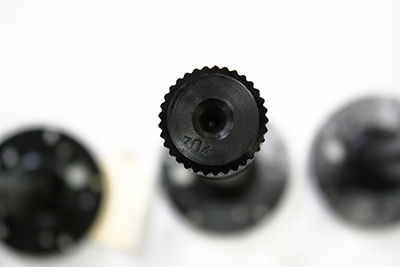4 Wheel Parts' Guide to Choosing an Axle
Truck and Jeep Replacement Axle Shafts
In this Article

The rule of thumb within the 4x4 and off-road community when it comes to axles is "bigger is better". 4 Wheel Parts carries a tremendous variety of replacement axle shafts and we've learned through research and experience that there is much more to the equation than size alone.
The next time you are in the market for replacement axle shafts, there are four factors of strength you should keep in mind.
Spline Count
The spline count is the number of splines on the shaft or carrier. It is important that the shaft and carrier have the same spline count, or they will not fit together properly and breaking the splines is simply a matter of time.
The general consensus is: the higher the spline count, the stronger the axle. There is a lot of truth to that statement, and it is a good general rule to follow, but other factors such as spline shape, angle, material and diameter all work determine the true strength of an axle.
Material
Not all axles are created equal. Some blends of steel are stronger than others and, generally, the stock axles are not built strong enough to handle much off-roading. There are three common material choices when it comes to axles:
- Carbon-Steel – This is the material used in stock axles. If your rig mostly sticks to the pavement, a carbon-steel axle should be plenty strong enough to handle your daily drive.
- High-Carbon-Steel – These factory replacement axles have many strength and tensile advantages over the carbon-steel, thanks to added silicon and heat treatment. They're a good axle on a budget, but you may want to upgrade for serious off-roading.
- Chromoly – A blend of nickel, chromium and molybdenum make chromoly axles resistant to corrosion and exceptionally strong. Any material blend beginning with 4xxx indicates a chromoly metal, the most common in aftermarket parts being 4340. While the tensile strength of 1040 axles is around 120,000 psi, 4340 is around 228,000 psi with 210,000 psi yield strength.
A vital factor in axle strength is whether the material has undergone the hardening process or not. Hardening steel tightens the grain of the metal, resulting in a stronger end product.
Spline Shape
"An axle is only as strong as the root of its splines," says Steven Deitsch, 4 Wheel Parts content specialist.
Axle splines come in two shapes: square and involute. Square splines are shaped precisely as you'd expect – 90 degree angles and the same width at the top of the spline as at the base. Involute splines, on the other hand, are wider at the base than at the top and have slightly curved faces for optimum contact and pressure distribution.
Square-cut splines are rarely used in modern axles, as they are much weaker than involute spines. Their shape forces the contact points between the shaft and the carrier to be very close together, causing extreme concentrations of stress and increasing the likelihood of stripping or breaking the splines.
Involute spines, on the other hand, are shaped to better distribute the stress points and are also self-centering.
Another important aspect of spline shape to keep in mind is whether the base of the splines have been undercut (pictured) or not. The down-step of the root of the splines allows for greater tensile strength in the axle.
Spline Cut
There are two common ways for an axle shaft to be splined:
- Rolling
- A properly rolled spline can be up to 35% stronger than a cut one. This is because it is a cold-working process, which removes no material from the spline and is done prior to hardening. Essentially, the material is put under extreme quantities of pressure to mold it into the appropriate shape, resulting in a more refined, consistent grain structure in the end product.
- Cutting
- This method cuts the splines one at a time and often does not produce a proper involute spline shape. It is also done after the hardening process, which can dramatically decrease the spline's ability to withstand stress. If properly manufactured, a cut spline can perform excellently, but it will never be able to achieve the strength of a rolled spline.
Join our mailing list to receive information on new products, special events, discounts and more!
Sign up to receive deals by email!
Sign up to receive text alerts about new product releases, exclusive access to sales, and much more!
Sign up to receive deals by text!
By submitting, you agree to receive recurring autodialed marketing text msgs (e.g. cart reminders) to the mobile number used at opt-in from 4 Wheel Parts (4WP) on 21208. Consent is not a condition of purchase. Msg frequency may vary. Msg & data rates may apply. Reply HELP for help and STOP to cancel. See Terms and Conditions & Privacy Policy








